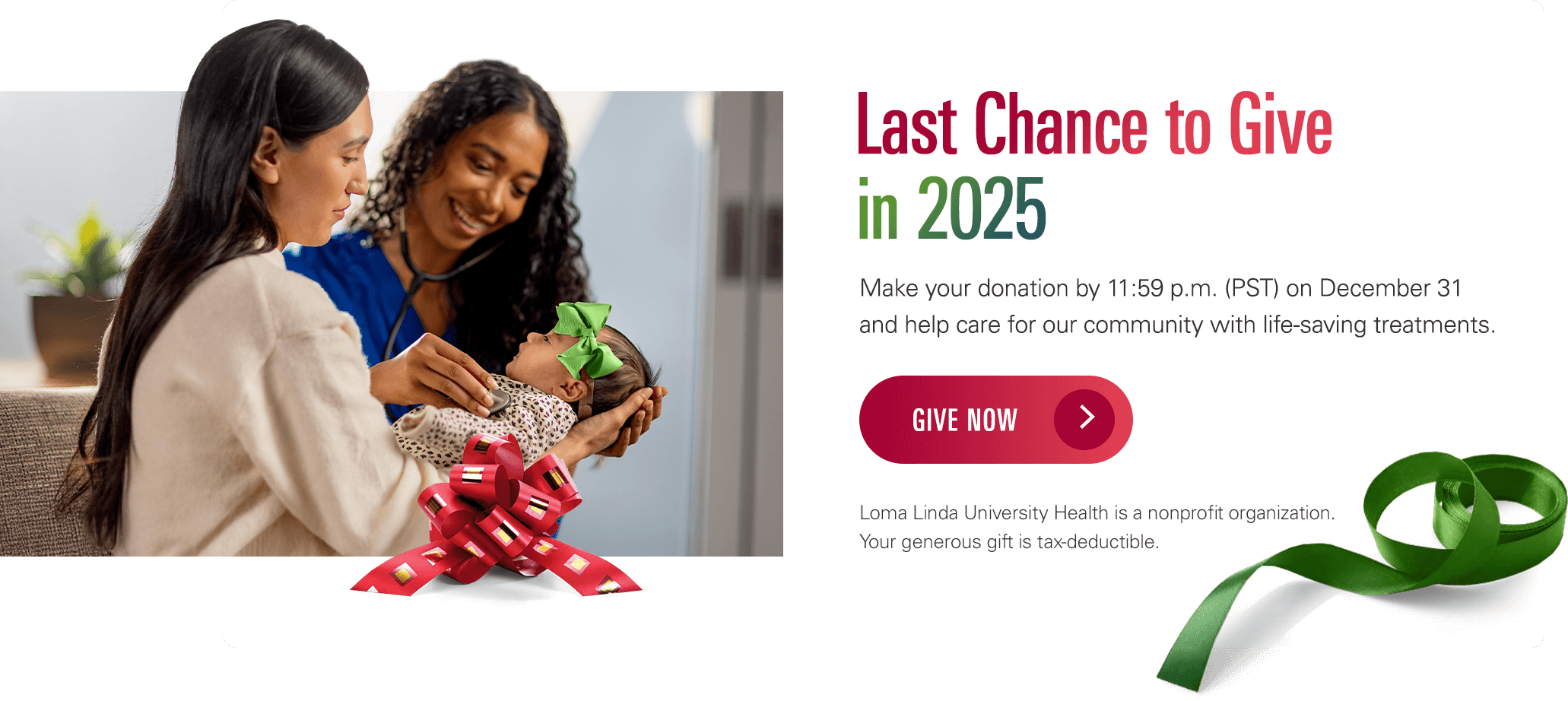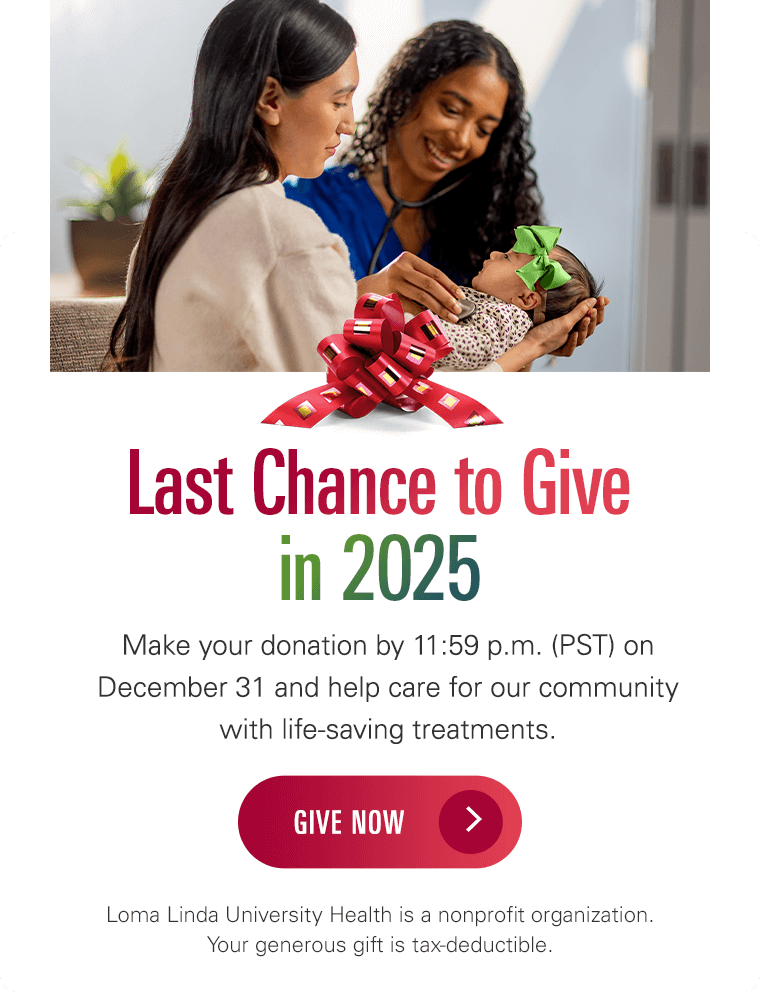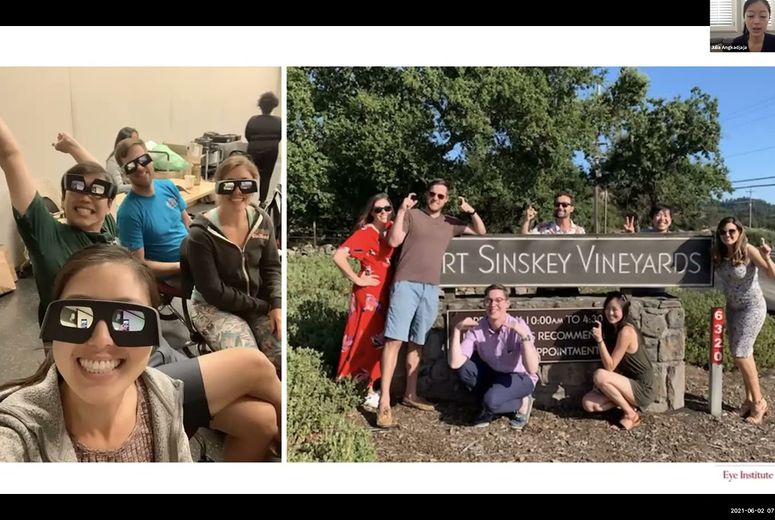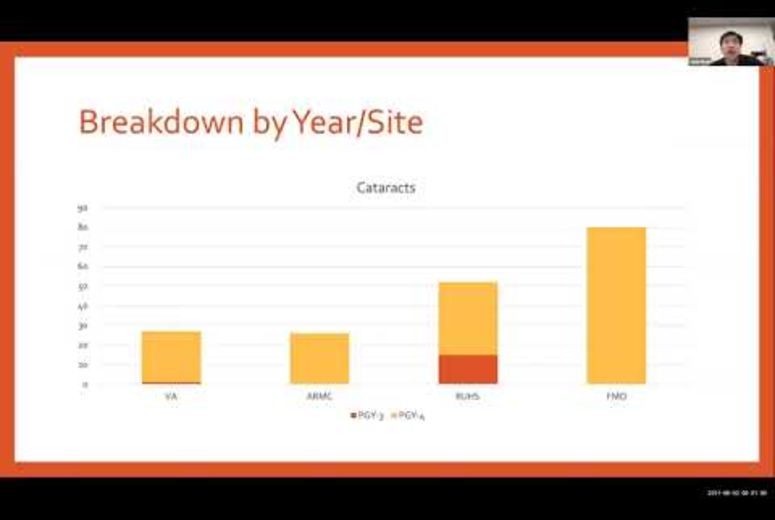Current Residents and Bios
Our goal is to provide excellent clinical and surgical training so that residents have the skills and knowledge to become outstanding ophthalmologists. Loma Linda University’s mission has always been “to make man whole”. We take pride in preparing ophthalmology residents for a lifetime of service both locally and globally, with opportunity for mission works during residency. Learn more about mission work.
The ophthalmology residency is a three-year program designed to provide intensive clinical training in an academic environment, which encourages close interaction between the residents and faculty. Five residents are accepted to our program each year.
Residency Program Director: Samantha Perea, MD
ACGME Accreditation
The ophthalmology residency has full and continued accreditation by the ACGME. The ACGME has also approved the programs request for a permanent increase in resident compliment allowing the program to now accept five new residents a year.
Clinical Facilities
The Loma Linda University School of Medicine mainly uses four institutions as education resources for its ophthalmology residency program.
The Loma Linda University Medical Center serves as both a university and community hospital. The Eye Institute, which serves a large population, is conveniently located at the Faculty Medical Offices directly across the street from the main Medical Center building. This facility serves as the primary training site for the subspecialty rotations.
The Jerry L. Pettis Memorial VA Medical Center, just five minutes away, serves as the referral center for a large portion of California. Veterans travel from as far as Arizona and Nevada to seek medical care at this facility. A new outpatient eye clinic, including wet lab, opened at this facility in 2005. It is a primary training site for comprehensive ophthalmology, including cataract surgery.
The Riverside University Health System (RUHS) is the county hospital for Riverside County. RUHS is located in the neighboring community of Moreno Valley, approximately 25 minutes away. It was built in 1998 and features a modern clinic. Its busy clinics serve a large indigent population with a mix of many immigrant groups. The faculty and residents run a comprehensive eye clinic at this facility.
The Arrowhead Regional Medical Center is a teaching hospital located in Colton, California within Southern California’s Inland Empire. ARMC is owned and operated by the County of San Bernardino.
San Diego Naval Medical Center Refractive Rotation
The San Diego Naval Medical Center Refractive Rotation in July 2007 introduced a refractive surgery elective for our senior residents through the San Diego Naval Medical Center. During this one-month rotation, our residents receive "hands on" refractive surgical training. The elective includes certification in IntraLase, keratome usage, PRK and LASIK. Our residents have averaged 70 refractive surgical cases within this rotation. Our residency is now one of the few programs in the country that provides such a comprehensive refractive surgery experience for its residents.
San Diego Naval Medical Center Pathology Rotation
The San Diego Naval Medical Center Pathology Rotation is for our first year residents. They spend three months (one day per week) at the San Diego Naval Medical Center training in Ocular Pathology. This rotation is under the direction of Dr. Todd Mondzelewski and Dr. John Cason.
San Diego Naval Medical Resident Rotation at Riverside University Health System
The San Diego Naval Medical Center senior residents currently rotate through the RUHS for a 1-month rotation. During this rotation, the SD Naval residents serve as the senior resident at Riverside County, working with Loma Linda University junior residents. Additionally, the residents provide "globe trauma" call coverage for the duration of the rotation. This eye trauma rotation serves a vital role for the SD Naval residency, providing critical experience for their residents before they begin their tours of duty after graduation.
Components of Residency Training
Didactic instruction includes faculty and guest speaker lectures and an ongoing program of weekly grand rounds, conferences, and lecture series that cover all subspecialties. Didactic lectures are held from 7:00 a.m. to 10:00 on Fridays. Grand Rounds, Neuro-Imaging and Fluorescein Conferences are held on a once to twice monthly basis on Wednesdays from 7:00 am to 8:30 am. Clinical training includes specialty clinics in retina, cornea, and refractive surgery, cataract management, glaucoma, pediatrics and strabismus, neuro-ophthalmology, oculoplastics, and uveitis, as well as extensive surgical experience in general and subspecialty ophthalmology. The residents and faculty work together within the clinics, and faculty are readily available for assistance.
Research
Residents are encouraged to pursue research projects and to seek post-residency fellowships; however, the first priority of the program is to insure the highest level of clinical knowledge and skill. Residents are required to complete one quality improvement project and one research project during their residency. One project must be submitted for publication. Residents are allotted time from their academic schedule and provided financial support to present their research at major medical meetings.
Clinical Rotations
The training is divided into four three-month rotation blocks per academic year. This will change as we increase our resident compliment up to five residents per year.
Residents rotate through most subspecialties twice throughout their residency. All of the facilities provide the resident with a great variety of general ophthalmology patient care experiences as well as management of chronic and age-related disease.
The PGY-2 residents focus mainly on clinical skills during their first year. Surgical focus of the PGY-2 trainee is on extra-ocular surgeries (mainly strabismus and oculoplastics). The PGY-2 residents also become proficient in the use of various lasers and intravitreal injections for in-office procedures.
The PGY-3 residents have designated surgical days and focus on extra-ocular as well as intra-ocular surgeries. PGY-3 residents perform cataract surgery at the VA Medical Center and RUHS, and achieve a significant surgical volume (approx. 40 cases) before they begin their PGY-4 year. They also play a crucial role in the education of medical students and PGY-2 residents.
The PGY-4 residents spend three months at each rotation site. The PGY-4 residents are the chief residents at their respective sites and have the responsibility of arranging journal clubs and grand rounds meetings as well as training the PGY-2 and PGY-3 residents. There is a strong emphasis on refining intraocular surgical skills during the senior year. Surgical case volume has consistently remained in the 80-90% versus the national averages. Here is the latest surgical case log data from our residency program compared to the national averages.
The videos below will help you understand the depth and breadth of the surgical training of our residents:
From the beginning of the residency program the residents develop their teaching and presentation skills. The residents assist in teaching the junior and senior medical students during their surgical electives through a series of lectures and in the clinical setting at each hospital.
Residents routinely present cases at the weekly grand rounds and monthly fluorescein conferences.
Mission Activities
The Loma Linda University faculty members are actively involved in mission related activities. Residents are encouraged to participate in a surgical mission trip, typically during their senior year of training. Past resident mission trip destinations have included Zambia, Guatemala, Bolivia, Dominican Republic, and Fiji. Two weeks are allotted for a mission trip, which can be extended with vacation time if desired. Funding is provided through the Robert Shearer MD Mission Fund and the Dorothy McNeil Walker Residency Fund.
Physicians in the Field: Narratives of International Medicine, Dr. Janie Yoo '06 from Alumni Association, LLUSM on Vimeo.
Recent Graduates
Where do our residents go after graduation?
What do our recent graduates have to say about the program?
- LLU Resident Graduate Responses
Surgical Training / Practice Facilities
Residents routinely record their surgeries on the Apple computers stationed in all of the OR facilities. The iMovie program is used to record and edit video for "real time" review in the OR or for subsequent self-study or conference presentations. The residents can practice surgical skills in the VA wet lab where a surgical microscope as well as phacoemulsification / vitrectomy machines are dedicated for resident practice.
Residency Oral Board Examination
Since 2006 the residency program has hosted an annual American Board of Ophthalmology “ style “ oral examination that mimics the exam graduates must take to achieve Board certification. Residency alumni and regional practitioners are recruited to serve as examiners. This invaluable experience is a highlight of the residency program.
The residency held its annual Oral board preparation examination on Sunday February 10, 2019.
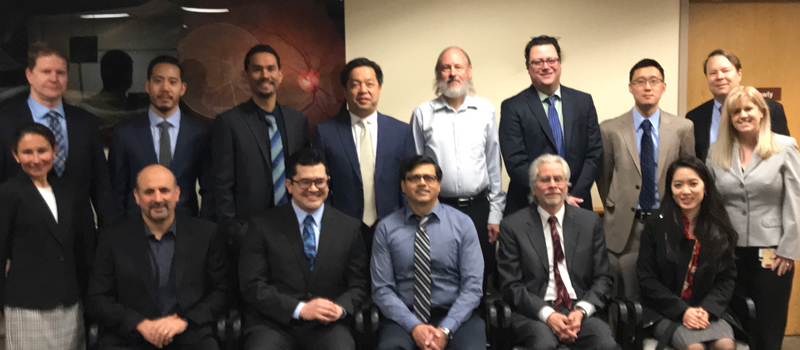
Shown in the photo are the physicians serving as examiners: Back Row L — R David Gano, Gintien Huang, Andrew Chung, Steven Zane, Bill Gruzensky , Peter Bekendam, Joseph Kim , Michael Rauser ( Chair) Front Row L — R: Leila Khazaeni ( Associate Program Director), Jack Carlson , Keith Tokuhara, Anshul Varshney, Kenneth Houchin , Rosalind Vo, Samantha Perea ( Residency Director)
Residents 2018-2019
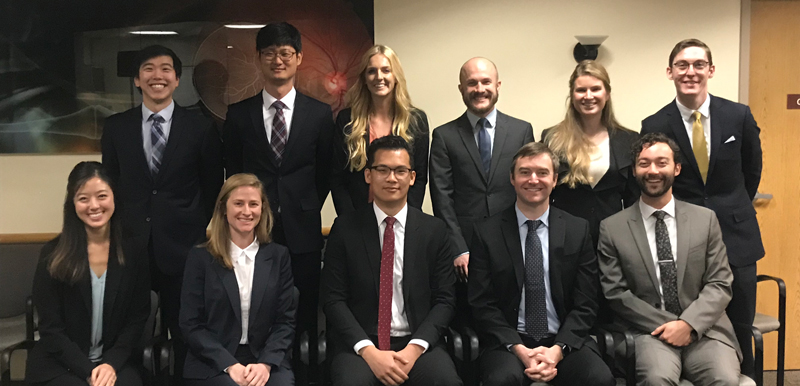
Top Row: John Pyun, Ji Kwan Park, Abby Vercio, Charles Maddux, Kaitlyn Pearson, Ryan House Bottom Row: Julia Angkadjaja, Stephanie Terrill, Caleb Ng, Justin Dredge, Nicholas Norton
Call Schedules
Residents provide call coverage for Loma Linda University Medical Center and the affiliated training sites. Residents receive extensive experience in the management of acute ocular emergencies, including ruptured globe repair. Call coverage days are divided equally between all residents. PGY-2 residents spend the majority of their call days as the first call resident, whereas the PGY-4 residents provide primarily backup call. PGY-3 call days are an equal mix of first and backup call.
Amenities
Loma Linda is a quiet residential community of 20,000. Located 60 miles east of Los Angeles in the San Bernardino Valley. The narrow valley is surrounded by the picturesque San Bernardino Mountains, which rise to over 11,000 feet. One of the advantages of living in the San Bernardino area is its proximity to a wide variety of recreational areas. The beach, mountains, and desert are all within one hour's drive.
To the north lies the San Bernardino National Forest. In addition to many ski resorts, Lake Arrowhead and Big Bear offer water skiing, swimming, hiking, mountain biking, boating, and camping.
To the east is Palm Springs with its world famous golf courses, natural spas, and exotic shopping.
To the west are sunny, spacious Southern California beaches such as Malibu and Laguna. Los Angeles offers many others nationally known recreational areas such as Disneyland, Magic Mountain, and Knott's Berry Farm. San Diego, a 90-minute drive to the south, offers the world famous San Diego Zoo, Sea World, beaches, and temperate weather.
Closer to home, Lake Perris is 20 minutes away and offers fishing, wind surfing, water skiing, and sailing.
The Drayson Center provides residents with indoor sports facilities including, basketball courts, a weight room, volleyball courts, racquetball courts, table tennis, and floor hockey. Outdoor facilities include tennis courts, football, and soccer fields. An extensive intramural sports program promotes friendly competition in softball, volleyball, football, soccer, and basketball. Classes and training are available in many outdoor and recreational activities including rock climbing, camping, tennis, and marathon race training.
Salary
Residents are paid competitive salaries according to the LLUMC stipend and benefits page.
Residency Benefits
In addition to the salary and benefits provided by LLUMC, department and alumni support allows for an additional benefit package to be provided.
We are grateful to the alumni for their generous support of our program.
Vacations / Conference Attendance
Residents receive four weeks of vacation each year, one week during each quarter for their PGY3 and PGY4 years. During the PGY2 year they receive three weeks of vacation and one week for travel and on boarding (first week of July). Residents also receive one week per academic year for attendance at major conferences or review courses.
Residency Application Process
Applications are accepted only through the SF Match. The SF matching program usually begins distributing applications the first of July. Our deadline for receiving applications from SF matching program is the end of September (allow at least two weeks from the date material arrives at the SF matching program to the date we receive the application). Applications that are incomplete by the deadline will not be considered.
Requirements
Applicants must meet the following requirements to be eligible for the residency: graduation from an LCME-accredited medical school in the United States or Canada, possess or be eligible for a California medical license, satisfactory completion of a PGY-I year in an accredited program in the United States or Canada, which includes a minimum of six months of broad experience in patient care, and in certain circumstances, graduates of foreign medical schools may be considered for the residency.
Interviews
Applications are carefully reviewed, and 30-36 candidates are invited for an interview. Interviewees will have an opportunity to meet faculty and residents, tour the training facilities, and learn about the program. Interviews are held in early November, and are conducted by the members of the resident selection committee on an individual basis.
For more information, please contact:
Jason Polanco, Residency Program Coordinator SR - [email protected]
Loma Linda University
Eye Institute
11370 Anderson, Suite 1800
Loma Linda, CA 92354
Phone: 909-558-2182
